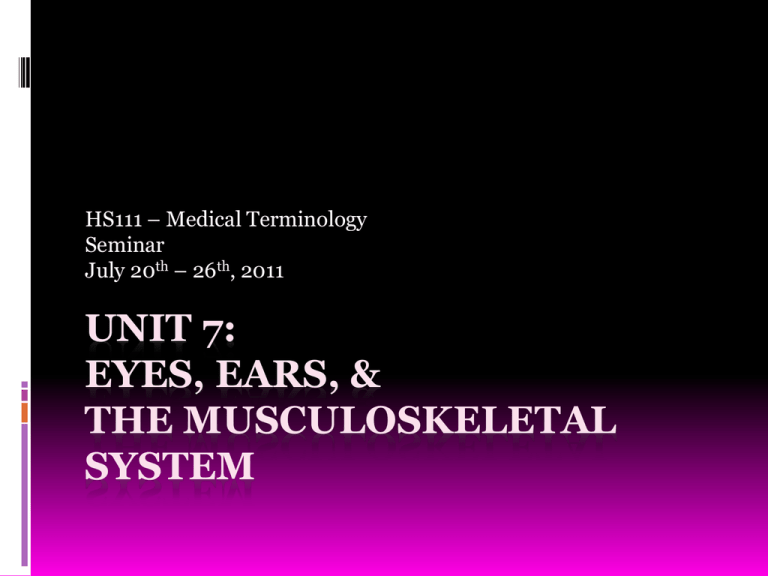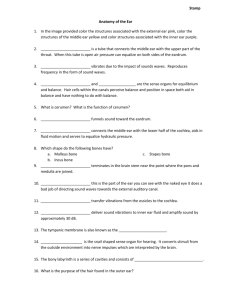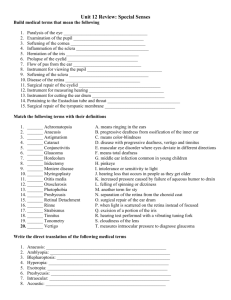Document
advertisement

HS111 – Medical Terminology Seminar July 20th – 26th, 2011 UNIT 7: EYES, EARS, & THE MUSCULOSKELETAL SYSTEM Learning Activities for this Week 1. Complete Reading – Ch. 12, 13, & 14 2. Participate in Discussion Board 3. Attend one of the flex seminars or complete Opt.2 assignment 4. Take Quiz by Tuesday 5. No project due, but there is in Unit 8 (all information in template found in ‘Doc Sharing’ tab) Chapter 12 EYE Characteristics of the Eyes Organs of vision Located in a bony protective cavity of the skull called the ‘orbit’ Only a small portion of the eye is visible from the exterior Structures include sclera, cornea, iris, pupil, lens, retina, optic nerve Structures of the Eye Combining Forms of the Eye More Combining Forms Cry/o.......................cold Dipl/o...........two, double Phot/o....................light Ton/o....tension, pressure Prefixes / Suffixes Prefix Bi-, bin-.......................two Suffixes -opia.......vision (condition) -phobia....abnormal fear of or aversion to specific things -plegia.................paralysis Quiz Breakdown: 1. Blepharitis 2. ophthalmalgia 3. retinopathy Disease & Disorder Terms Blepharoptosis – drooping of the eyelid Conjunctivitis – aka pink eye Oculomycosis – abnormal condition of the eye caused by fungus Diplopia – double vision Blepharitis – inflammation of the eyelid Ophthalmalgia – pain in the eye Cataract – clouding of the lens of the eye Sty – infection of oil gland of eyelid (aka hordeolum) Nyctalopia – poor night vision Surgical Terms Blepharoplasty – surgical repair of eyelid Dacryocystotomy – incision into tear sac Enucleation – surgical removal of eyeball Diagnostic & Complementary Terms Tonometry – measurement of eye pressure Keratometer – instrument used to measure curvature of the cornea (to fit contact lenses) Binocular – pertaining to 2 or both eyes Intraocular – pertaining to w/in the eye Ophthalmopathy – disease of the eye Visual acuity (VA) – sharpness of vision for either distance or near Chapter 13 EAR Characteristics of the Ears 2 Functions: 1. hear; 2. provide sense of balance 3 parts: 1. external ear; 2. middle ear; 3. inner ear (aka labyrinth) We hear b/c sound waves vibrate through the ear where they are transformed into nerve impulses that are then carried to our brains Structures include auricle, tympanic membrane (eardrum), ossicles, cochlea Structures of the Eye Combining Forms of the Ear Audi/o..................................hearing Aur/i, aur/o, ot/o.........................ear Cochle/o.............................cochlea Labyrinth/o......labyrinth (inner ear) Mastoid/o..................mastoid bone Myring/o........tympanic membrane (eardrum) Staped/o...............................stapes (middle ear bone) Tympan/o.......tympanic membrane (eardrum); middle ear Vestibul/o..........................vestibule Quiz Please define: 1. Mastoidectomy 2. Myringotomy 3. Tympanoplasty Disease & Disorder Terms Tympanitis – inflammation of middle ear (aka. Otitis media) Otomycosis – abnormal condition of fungus in ear Otalgia – pain in the ear Otomastoiditis – inflammation of ear and mastoid bone Myringitis – inflammation of tympanic membrane Presbycusis – hearing impairment in old age Tinnitus – ringing in the ears Surgical Terms Labyrinthectomy – excision of the labyrinth Myringotomy – incision into the tympanic membrane Tympanoplasty – surgical repair of middle ear Diagnostic & Complimentary Terms Audiogram – graphic record of hearing Otoscope – instrument used for visual exam of ear Audiology – study of hearing Chapter 14 MUSCULOSKELETAL SYSTEM Characteristics of the Musculoskeletal System Made up of muscles, bones, and joints Body has 206 bones and 600+ muscles Joints are located any place 2+ bones meet Functions of muscular system => movement, posture, joint stability, and heat production Functions of skeletal system => provide a framework for body, protect soft body parts (ex brain), store calcium, and produce blood cells List of structures and bones on pp.608-612 Joints hold our bones together and make movement (p.614) Muscles – skeletal, smooth, cardiac (p. 615-618) Types of Body Movement Abduction – movement of drawing away from the middle Adduction - movement of drawing toward the middle Inversion – turning away Eversion – turning outward Extension – movement in which a limb is placed in a straight position Flexion – movement in which a limb is bent Pronation – movement that turns the palm down Supination – movement that turns the palm up Rotation – turning around its own axis (some) Combining Forms of Musculoskeletal System Cost/o....................................rib Patell/o.........................kneecap Stern/o.....................breast bone Spondyl/o...................vertebrae Mandibul/o..........lower jawbone Chondr/o......................cartilage Arthr/o...............................joint Oste/o...............................bone Tend/o............................tendon Kinesi/o.........movement, motion Scoli/o................crooked, curved Prefixes & Suffixes Prefixes Inter-.........................between Supra-..........................above Sym-, syn-.....together, joined Suffixes -asthenia..................weakness -clasia, -clasis, -clast.......break -desis..............surgical fixation, fusion -physis..........................growth -schisis..................split, fissure Quiz Definition 1. Cost/o 2. Oste/o 3. -physis Disease & Disorder Terms Arthritis – inflammation of a joint Ankylosis – abnormal condition of stiffness Myasthenia – muscle weakness Fracture – broken bone Carpal tunnel syndrome – painful compression of a nerve in the wrist Gout – disease in which an excessive amt of uric acid in the blood causes sodium urate crystals to be deposited in the joints Surgical Terms Chrondroplasty – surgical repair of cartilage Tenomyoplasty – surgical repair of a tendon and a muscle Ostectomy – excision of a bone Cranioplasty – surgical repair of the skull Myorrhaphy – suture of a muscle Diagnostic & Complimentary Terms Arthrography – radiographic imaging of a joint Atrophy – w/out development (wasting) Dyskinesia – difficult movement Intracranial – pertaining to w/in the cranium Podiatrist – specialist who treats and diagnoses foot diseases and disorders Chiropractic – system of therapy that consists of manipulation of the vertebral column Good Night & Have a Great Week!

